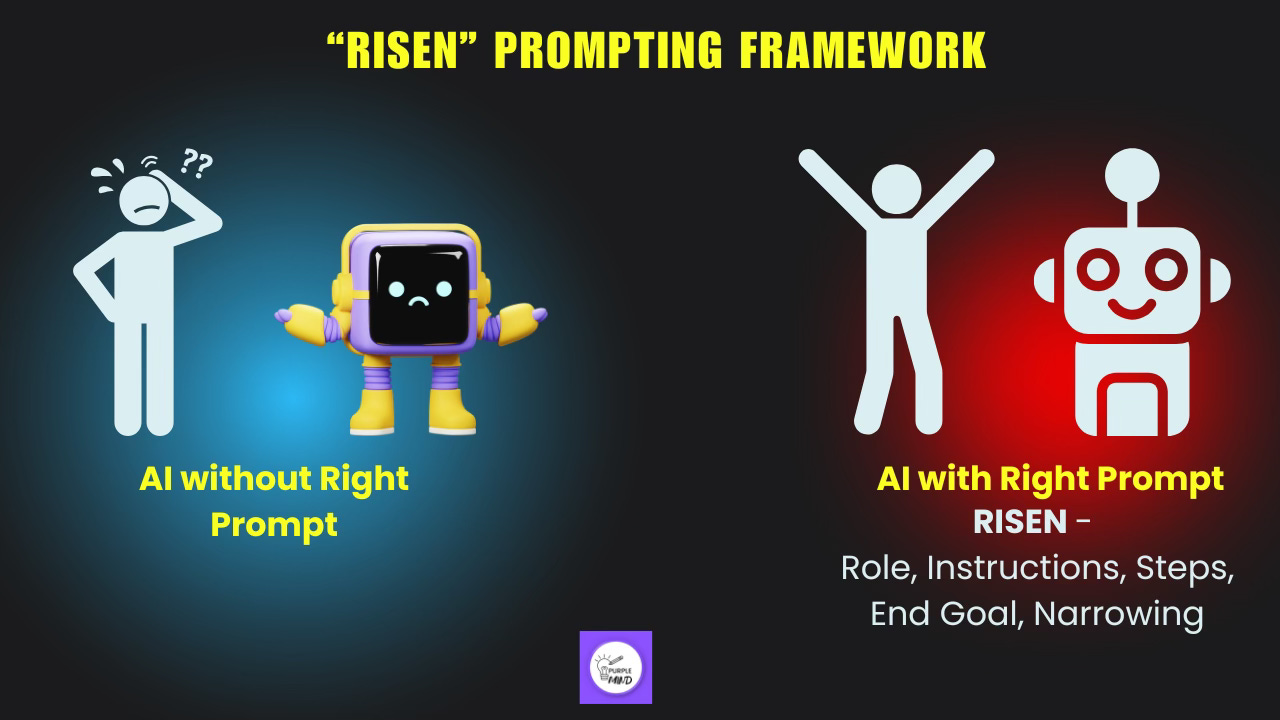The RISEN Framework: How to Get AI to Give You Exactly What You Need
You know that feeling when you ask AI for something and the response is... meh? It’s not that AI isn’t capable—it’s that the prompt wasn’t clear enough.
Think of it like giving directions. If you just say, “Take me somewhere nice,” you might end up at a random park when you really wanted a beach. But if you say, “Take me to a quiet beach with white sand and clear water, within 30 minutes from here”, you’ll get much closer to what you actually want.
That’s where RISEN comes in. Kyle Balmer created this framework to help structure prompts in a way that AI understands exactly what you need.
What is RISEN?
It’s a simple method to structure your prompts so you get better AI-generated responses. Each letter stands for a key element:
LetterWhat It MeansWhy It MattersRRoleTell AI who it is—this sets the right context. (e.g., "You are a marketing expert.")IInstructionsClearly explain what you need AI to do. No vague requests.SStepsBreak the task into logical steps so AI follows a structured approach.EEnd GoalDefine what a great response looks like so AI doesn’t go off track.NNarrowingSet constraints like word limits, style, or format to refine the response.
How to Use RISEN (A Simple Formula)
Whenever you’re crafting a prompt, follow this structure:
🟡 Role: What role should AI take on? (e.g., expert marketer, data analyst, storyteller)
🟡 Main Task: What exactly do you need? Be clear and specific.
🟡 Steps: What logical steps should AI follow to complete the task?
🟡 End Goal: What’s the ideal outcome? How should the final response look?
🟡 Constraints: Any limitations? (word count, style, avoid jargon, etc.)
Example: Creating a Digital Course Prompt
Let’s say you want AI to help you plan an online course about AI.
Bad Prompt (Too Vague)
"Tell me what to include in an AI course."
🚫 Problem: AI might give you a generic, unstructured answer that’s not detailed enough.
Good Prompt (Using RISEN)
Role: You are an expert digital course creator who has generated millions in online course sales.
Main Task: Create a detailed list of everything an AI course should include + strategies for revenue growth.
Steps:
1️⃣ Start by listing the core elements that ANY online course should have.
2️⃣ Then, focus on the unique topics an AI course should cover.
3️⃣ Finally, suggest proven marketing strategies to maximize course sales.
End Goal: A structured, actionable course outline + revenue-maximization strategies.
Constraints: Keep it under 500 words. No jargon. Make it easy to follow.
✅ Result? Instead of a random, half-baked answer, AI now gives you a structured, practical, and useful response.
Why RISEN Works
🚀 Gives AI a clear role, so responses match expert-level insights.
🚀 Uses step-by-step instructions, so the output is logical and easy to follow.
🚀 Sets clear goals and constraints, so you don’t get irrelevant fluff.
Example 1: Writing a Blog Post with AI
🚫 Bad Prompt (Too Vague)
"Write a blog post about productivity."
✅ RISEN Prompt (Well-Structured)
Role: You are a productivity expert who has coached thousands of entrepreneurs.
Main Task: Write a blog post on effective time management techniques for solopreneurs.
Steps:
1️⃣ Start by explaining why time management is a challenge for solopreneurs.
2️⃣ Introduce 3-5 practical techniques they can use daily.
3️⃣ Include real-world examples of how these techniques have helped entrepreneurs.
End Goal: A well-structured, engaging blog post that provides actionable insights.
Constraints: 1,000 words max. Write in a conversational tone. No fluff—keep it practical.
🔹 Why this works: AI now has a clear role, a structured approach, and an expected outcome.
Example 2: Generating Social Media Content
🚫 Bad Prompt
"Write a tweet about AI in business."
✅ RISEN Prompt
Role: You are a business strategist specializing in AI automation.
Main Task: Write an engaging tweet about how AI is changing solopreneurship.
Steps:
1️⃣ Hook with an attention-grabbing fact about AI in business.
2️⃣ Briefly explain how solopreneurs can use AI for growth.
3️⃣ End with a thought-provoking question or call to action.
End Goal: A compelling tweet that encourages discussion.
Constraints: Max 280 characters. Keep it simple and engaging.
🔹 Why this works: AI now understands the tone, purpose, and format of the response.
Example 3: Creating an AI-Powered Business Strategy
🚫 Bad Prompt
"Help me grow my online business."
✅ RISEN Prompt
Role: You are a business consultant who has helped multiple startups scale to 7 figures.
Main Task: Create a 3-month AI-powered growth strategy for my online business.
Steps:
1️⃣ Identify key areas where AI can automate tasks (marketing, customer support, etc.).
2️⃣ Provide specific AI tools that can help optimize these areas.
3️⃣ Suggest a step-by-step plan for implementing AI in my business.
End Goal: A structured 3-month strategy that outlines clear action steps.
Constraints: Keep it under 700 words. No jargon—make it easy to understand.
🔹 Why this works: AI now delivers a structured plan instead of generic advice.
Prompt Framework
You are a [expert/professional role] with [X years of experience] specializing in [specific field]. Your task is to help me [describe the task] by following a structured approach.
Steps:
1️⃣ First, [describe the first step AI should take].
2️⃣ Next, [explain what AI should do in the second step].
3️⃣ Finally, [describe the last step AI should complete].
The output should be [describe what a great response looks like].
Constraints:
[Word limit]
[Writing style preferences]
[Any specific do’s and don’ts]
Please provide a clear, structured, and actionable response.
Final Thoughts
If you’ve ever been frustrated by vague or generic AI responses, it’s not the AI—it’s the prompt. The RISEN framework helps you get precise, useful, and high-quality responses every time.
Big shoutout to Kyle Balmer for this game-changing approach. Try it the next time you use AI—you’ll instantly see the difference! 🚀


